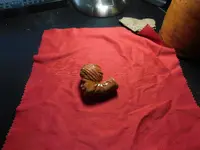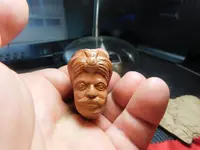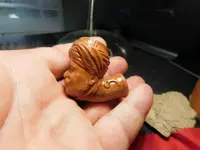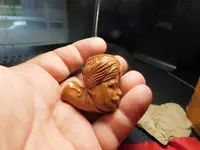You are using an out of date browser. It may not display this or other websites correctly.
You should upgrade or use an alternative browser.
You should upgrade or use an alternative browser.
Best pipe bowl I have ever seen found...Nice bottle too...
- Thread starter Calabash Digger
- Start date
- Joined
- Dec 23, 2019
- Messages
- 6,392
- Reaction score
- 20,314
- Golden Thread
- 0
- Location
- Surrey, UK
- Primary Interest:
- All Treasure Hunting
Thats an awesome find any idea who its supposed to be ? Those are some cool finds I got a bucket waiting on one of those pipes.
The “Turk’s Head” doesn’t represent a particular person. As an emblematic design, it probably has its roots in the times of the Crusades, when turbaned "Turks", along with "Saracens" were the non-Christian (synonymous with Muslim or Arab) enemies. Even before the Crusades proper began in 1096, the spread of the Ottoman Empire resulted in frequent raids of European coastal towns by pirates and slave-traders operating out of the Iberian peninsula and, after they had been pushed back, from North African ports such as Salé, Rabat, Algiers, Tunis, and Tripoli. These later raids, from the 16th Century, peaking in the mid-17th Century and through to about 1780 were conducted by what came to be known as “Barbary corsairs”, who captured thousands of European merchant ships and tens of thousands of slaves, making large stretches of the Spanish and Italian coasts unwise places to live.
The raids extended as far north as Iceland and Britain didn’t escape. On the extreme southwest tip of Britain sits the port of Penzance, which saw frequent raiding in Mediaeval times, leading to one of it’s taverns adopting the name of “The Turk’s Head” around 1233 and there is still a pub of that name with the turbaned head sign on that site today. There’s another one in Exeter on the same stretch of coast dating to 1289 with unsubstantiated claims that the name derives from its former use as a prison when a Turkish captive was held there prior to his appointment with the axe; or that there used to be a jousting ground at the rear of the establishment where a Saracens Head was used as a target.
Thereafter, it became a popular name for pubs around the country, including those that were far inland and never saw any pirate raids, and the imagery progressively crept into all kinds of ornamentation, from furniture to tobacco pipes... spreading to pipemakers in America too. We still have dozens (perhaps hundreds) of pubs with the “Turk’s Head” sign today, as well as numerous “Saracen’s Head” pub signs with the same imagery.
Last edited:
xcopperstax
Silver Member
- Joined
- Sep 3, 2018
- Messages
- 2,508
- Reaction score
- 4,873
- Golden Thread
- 0
- Location
- Massachusetts
- Detector(s) used
- Garrett AT Max
- Primary Interest:
- All Treasure Hunting
That's a beautiful pipe bowl and nice bottle too! Not only is it a really cool design but it's complete. The clay pipes with the long stems are going to be pretty hard to find intact. I've found a couple clay pipe bowls but nothing of that caliber!
WannaDig3687
Platinum Member
The “Turk’s Head” doesn’t represent a particular person. As an emblematic design, it probably has its roots in the times of the Crusades, when turbaned "Turks", along with "Saracens" were the non-Christian (synonymous with Muslim or Arab) enemies. Even before the Crusades proper began in 1096, the spread of the Ottoman Empire resulted in frequent raids of European coastal towns by pirates and slave-traders operating out of the Iberian peninsula and, after they had been pushed back, from North African ports such as Salé, Rabat, Algiers, Tunis, and Tripoli. These later raids, from the 16th Century, peaking in the mid-17th Century and through to about 1780 were conducted by what came to be known as “Barbary corsairs”, who captured thousands of European merchant ships and tens of thousands of slaves, making large stretches of the Spanish and Italian coasts unwise places to live.
The raids extended as far north as Iceland and Britain didn’t escape. On the extreme southwest tip of Britain sits the port of Penzance, which saw frequent raiding in Mediaeval times, leading to one of it’s taverns adopting the name of “The Turk’s Head” around 1233 and there is still a pub of that name with the turbaned head sign on that site today. There’s another one in Exeter on the same stretch of coast dating to 1289 with unsubstantiated claims that the name derives from its former use as a prison when a Turkish captive was held there prior to his appointment with the axe; or that there used to be a jousting ground at the rear of the establishment where a Saracens Head was used as a target.
Thereafter, it became a popular name for pubs around the country, including those that were far inland and never saw any pirate raids, and the imagery progressively crept into all kinds of ornamentation, from furniture to tobacco pipes... spreading to pipemakers in America too. We still have dozens (perhaps hundreds) of pubs with the “Turk’s Head” sign today, as well as numerous “Saracen’s Head” pub signs with the same imagery.
Thanks, Red-Coat, for sharing that history with us.



xcopperstax
Silver Member
- Joined
- Sep 3, 2018
- Messages
- 2,508
- Reaction score
- 4,873
- Golden Thread
- 0
- Location
- Massachusetts
- Detector(s) used
- Garrett AT Max
- Primary Interest:
- All Treasure Hunting
Thought I should mention this. My buddy just found a pair of the John Adams cufflinks linked. He was looking into it and they might be the only known linked pair. Pretty astounding find!
pa-dirt_nc-sand
Silver Member
- Joined
- Apr 18, 2016
- Messages
- 4,267
- Reaction score
- 15,088
- Golden Thread
- 2
- Location
- South Western PA
- 🥇 Banner finds
- 2
- 🏆 Honorable Mentions:
- 2
- Detector(s) used
- ACE 250 with DD coil
Equinox 600
- Primary Interest:
- Metal Detecting
Such a cool find! Congrats
Calabash Digger
Gold Member
- #26
Thread Owner
Thought I should mention this. My buddy just found a pair of the John Adams cufflinks linked. He was looking into it and they might be the only known linked pair. Pretty astounding find!
I saw one linked pair I believe in the Massachusetts State Museum when I was researching mine. Tell him I said congrats!!
Calabash Digger
Gold Member
- #27
Thread Owner
Headed back out Tuesday cant wait to see what else shows up...
Patriot Relics
Silver Member
Very nice pipe bowl
Similar threads
- Replies
- 6
- Views
- 1K
Users who are viewing this thread
Total: 1 (members: 0, guests: 1)









